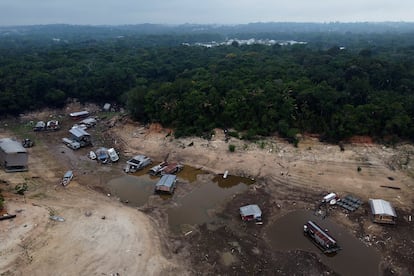Hundreds of dolphins killed by record 41-degree heat in Amazonian waters: “It was so hot they had no shelter”

Aquatic ecosystems around the world are warming, and the Amazon has not been immune to this phenomenon . In recent years, the rivers and lakes of the planet's largest rainforest have recorded unprecedented levels of heat, a symptom of the global warming that is transforming the tropics. In 2023, a drought and an extreme heat wave raised water temperatures to levels never before recorded: up to 41 degrees Celsius, according to a study published this Thursday in the journal Science . This warming has particularly impacted marine species and the survival of riverside communities that depend on water for their livelihoods.
The study, led by Brazilian researcher Ayan Fleischmann of the Mamirauá Institute for Sustainable Development , analyzed ten lakes in the central Amazon. In five of them, the water temperature exceeded 37 degrees Celsius. In Lake Tefé, measurements reached 41 degrees Celsius throughout its water column, which was only two meters deep. The scientist described the event as “a perfect storm”: extreme solar radiation, shallow depth, weak winds, and murky water, all of which prevented sunlight from dispersing.
An ecological and humanitarian crisisThe drought not only lowered the river levels but also heated them to extreme temperatures. “It was impossible to put a finger in the water. It was so hot that the animals had no shelter. The fish and dolphins died because there was no cool water at the bottom of the lake,” he laments. “It’s an ecological and humanitarian crisis at the same time.”
All components of the ecosystem—fish, dolphins, phytoplankton—were affected. The team documented more than 200 dead dolphins in Lake Tefé. “These temperatures exceed the thermal tolerance of most Amazonian species. But for some reason, the dolphins didn't flee; they remained in this lake until they died.” The warming also disrupted the food chain. “The lake turned red due to algae that changed their pigmentation,” Fleischmann notes.
Moving through the drought-stricken region , Fleischmann says, proved challenging, not only because of the mobility issues, but also because of the emotional toll it took on the team. “What normally took three hours by boat became eight or ten. And besides the heat, many colleagues were deeply affected by what they saw: hundreds of dolphin carcasses, entire isolated communities, people without water or food.”
The impact, explains Pepe Álvarez, a Spanish biologist based in Peru, was devastating for aquatic life. Not only because of the deaths, but also because of the disruption of their reproductive cycles. Fish that typically release eggs in large schools (like carachamas and boquichicos) depend on annual floods to reproduce. However, during the droughts of those years, river levels dropped so low that thousands of fish were trapped in isolated lakes. “In Peru, there wasn't as much visible mortality as in Brazil, but there was a brutal shortage of fish.”

Droughts paralyzed daily life in the Amazon. Thousands of riverside families were left without transportation, water, and fish, their main source of food. A UNICEF report from November 2024 estimated that more than 420,000 children were affected by the lack of water and the inability to attend school. In Brazil, more than 1,700 schools and 760 health centers became inaccessible due to low river levels.
“When the fish die, food security is jeopardized,” Fleischmann summarizes. Transportation, education, and commerce depend on water in riverside communities. “If navigation is impossible, the entire social economy of the region is disrupted.”
The article by Fleischmann and his team focuses on 2023, the year they began studying the phenomenon. However, it extended into 2024. “We can say that it was the worst drought ever recorded,” the hydrologist states. “We don’t know what happened in previous centuries, but we can say with certainty that, based on the data we have, it was the worst drought in at least 120 years.”
According to researchers, the region is experiencing a sustained warming process—0.6°C per decade since 1990—driven by deforestation, extreme droughts, and global climate change . “The lakes have been warming continuously over the past few decades, and when that trend is combined with extreme drought, it creates ideal conditions for the waters to heat up even further and trigger what we call a late-season heat wave,” Fleischmann explains.

For Dr. Adalberto Val, who has spent more than forty years studying the physiology of Amazonian fish from his laboratory in Manaus (Brazil), climate change acts here as a multidimensional driver: “It affects the forest, the air, the rivers, the lakes, and everything that lives in them.”
According to a researcher at the Brazilian Institute of Amazonian Research (INPA) , most Amazonian aquatic organisms are extremely sensitive to heat. “When the temperature rises, the oxygen-poor waters become even more hypoxic. In areas like the Rio Negro basin, where the water is already naturally acidic, it becomes even more acidic. It’s a lethal combination.” The result, he says, was evident during the droughts of 2023 and 2024: a massive die-off of animals. “Fish can’t regulate their body temperature. When the water reaches 41 degrees Celsius, they simply stop functioning: their enzymes shut down, their metabolism collapses, and they die.”
The scientist describes a scenario of ecological imbalance. “Lake Tefé lost 75% of its area. It went from 400 to 100 square kilometers. From thirteen meters deep, it shrank to half a meter.” And the dolphins, capable of regulating their body temperature, couldn't survive . “They have to expend an enormous amount of energy to stay alive, and in a depleted environment, without food or shelter, they can't sustain that effort.”
A pattern that repeats itselfThe droughts of 2023 and 2024 were not isolated incidents. Two years earlier, Brazil suffered its worst drought in nearly a century, with record low rainfall and severe agricultural and energy impacts.
In 2023, river levels dropped by up to 20 centimeters per day. But 2024 marked a remarkable improvement: Amazonian deforestation fell to 5,796 km² , 11% less than the previous year, the best figure in over a decade. The government of Luiz Inácio Lula da Silva, with Minister Marina Silva at the head of the environmental sector, strengthened enforcement, reactivated the Amazon Fund , and coordinated 19 ministries in a crusade to curb logging. This effort coincides with the climate summit (COP30) , which will be held from November 10 to 21 of this year in Belém, in the heart of the Amazon.
For Núria Bonada, Professor of Ecology at the University of Barcelona, climate change is profoundly altering the planet's hydrological patterns. "Around 60% of the world's river network suffers droughts every year, and all indications are that they will become more frequent and prolonged," she warns. In this context, the Amazon basin—under-monitored and with high biodiversity—is emerging as one of the most vulnerable systems.
Even so, Ayan Fleischmann resists fatalism: “Two hundred dolphins died in Lake Tefé, but there are thousands of lakes where this didn't happen. There is still time to change and prevent this from happening again.”
EL PAÍS




